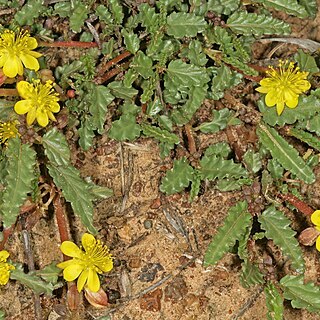Leaf-lamina 1·5–8 × 0·2–1·5 cm., lanceolate, narrowly oblong or almost linear, apex acute or subacute, rounded or broadly cuneate at the base, dentate-crenate or serrate, toothing very variable in size, sometimes irregular or biserrate and from very coarsely to rather finely toothed, basal setae absent, glabrous on both surfaces or sparsely to densely hispid with tubercle-based hairs; petiole up to 1 cm. long, pubescent at least on the upper side; stipules up to 1 cm. long, setaceous, setulose-pubescent.
Perennial herb. Stems procumbent or suberect. Leaves with blade linear to narrowly oblong-ovate, 15-80 x 2-15 mm, base rounded or broadly cuneate, margins coarsely crenate-dentate. Flowers: in single 1-3-flowered cymes; sepals 6-10 mm long; petals as long as sepals, yellow; Sep.-May. Fruit often on rather twisted or curved pedicels, capsule 20-30 mm long, sparsely setulose-scabrid.
Inflorescences of solitary 1–3-flowered cymes opposite or subopposite the upper leaf-axils; peduncle obsolete or up to 4 mm. long, pubescent or glabrous; pedicels similar, up to 5 mm. long; bracts c. 2·5 mm. long, setaceous, pubescent.
Perennial herb, with prostrate or suberect annual stems from a woody rootstock; stems glabrous or with a line of short curly hairs on one side only, or with spreading hairs all round the stem as well as the line of short curly hairs.
Capsule 2–3 cm. long, many-seeded, often on a rather twisted pedicel and therefore variable in its presentation, subcylindric not 3-angled, sparsely setulose-scabrid, attenuated to a blunt undivided apex.
Prostrate or suberect perennial herb. Leaves linear to narrowly oblong-lanceolate, margin coarsely crenate-dentate. Capsule 3-or 4-valved, fruiting pedicel curved. Flowers yellow.
Sepals 6–10 mm. long, linear to linear-oblanceolate, glabrous on both sides or setulose-pubescent at the back, acuminate but not caudate at the apex, not keeled.
Petals yellow, the same length as the sepals, oblanceolate to obovate, with a basal ciliate claw c. 0·75 mm. long.
Ovary trigonously subcylindric, very shortly setulose-pubescent, 3-locular; style 2–7 mm. long, glabrous.
Androgynophore c. 0·3 mm. long, extended above into a slightly undulate annulus.
Seeds dark brown, 1·3–2 × 0·75–1·0 mm., shortly cylindric.
Stamens very numerous.

